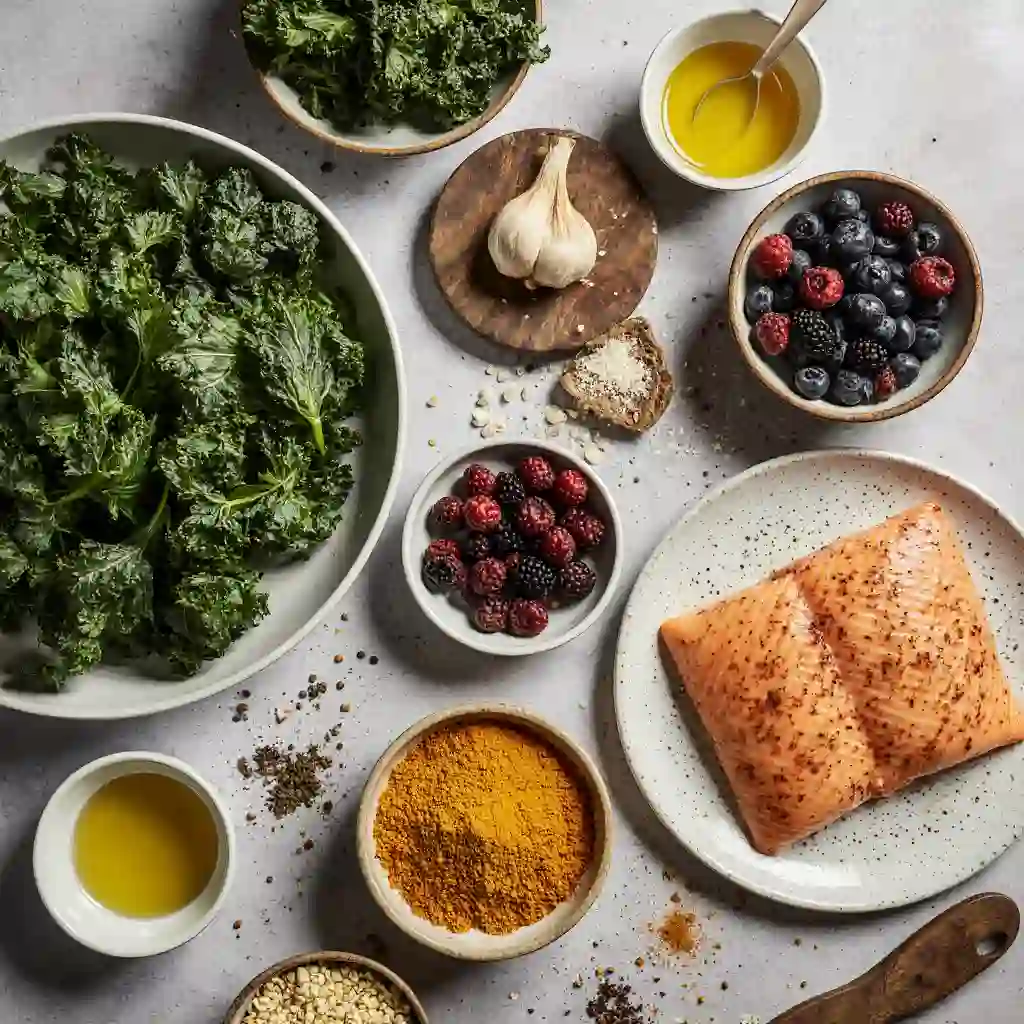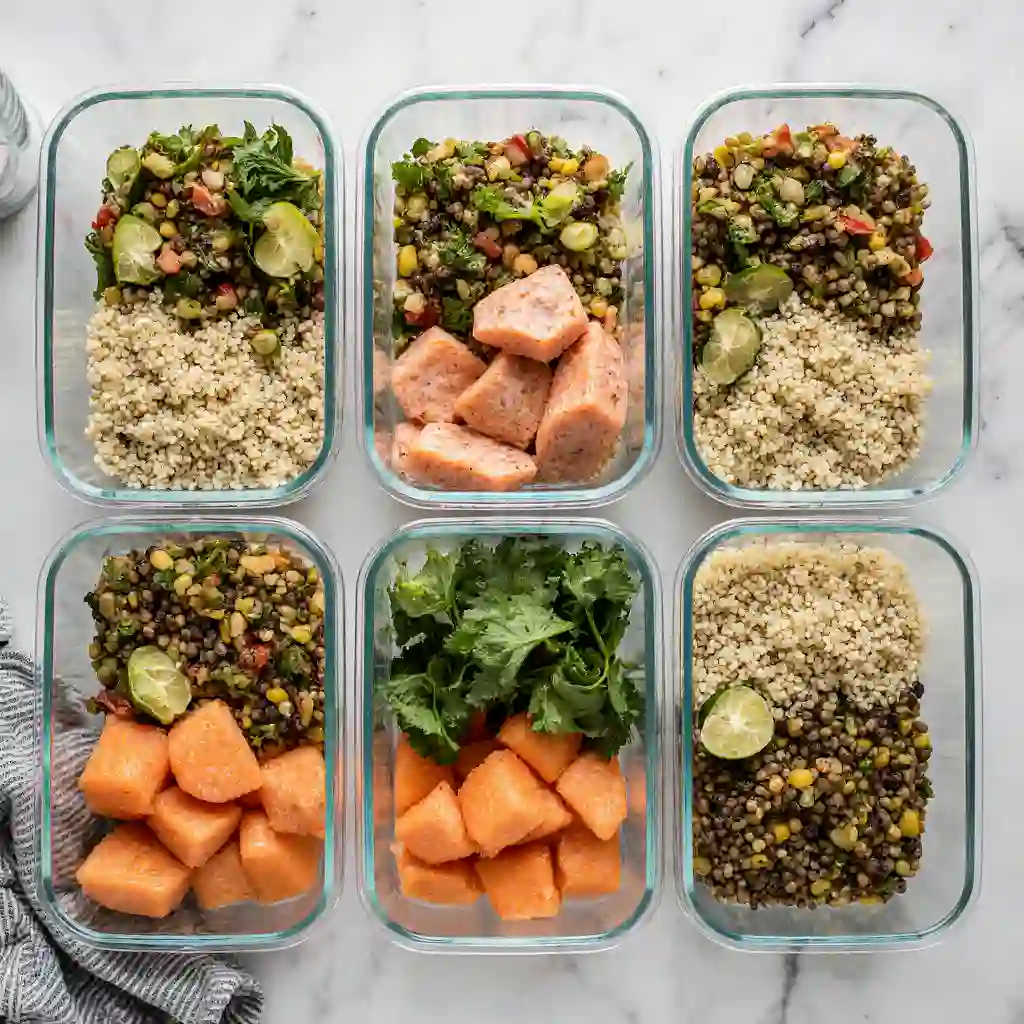When your body feels heavy, bloated, or just “off,” it could be a sign of inflammation working behind the scenes. Shifting to anti‑inflammatory eating doesn’t mean giving up flavor or joy in food—it means choosing ingredients that help your body heal, digest better, and feel more energized.
In this guide, you’ll learn how to build a balanced anti‑inflammatory plate, shop smart for weekly essentials, and save time in the kitchen. You’ll also get a simple, nourishing 7‑day meal plan to make your new habits stick. Whether you’re just getting started or want to stay consistent, these anti‑inflammatory meal planning tips will help support your wellness goals.
Meal Planning Tips: How to Build Your Plate for Anti‑Inflammatory Benefits
Meal Planning Tips: Balance the ‘Rainbow’ Approach
The more color on your plate, the more anti‑inflammatory nutrients you’re feeding your body. Bright orange sweet potatoes, deep green kale, juicy red tomatoes, and purple cabbage all contain antioxidants that calm inflammation at the cellular level. Try to fill at least half your plate with vegetables and fruits at every meal.
Focus on variety—not just greens. Rotate colors through the week and include both raw and cooked veggies. Berries, citrus, beets, and bell peppers are just a few colorful foods rich in polyphenols and vitamin C, both known for their inflammation-fighting power.
Meal Planning Tips: Include Healthy Proteins and Omega‑3s
Next, make room for protein—about a quarter of your plate. Choose anti‑inflammatory options like wild salmon, sardines, and trout, which are packed with omega‑3 fatty acids. Legumes such as lentils, chickpeas, and black beans also offer plant‑based protein with added fiber.
If you eat meat, choose lean poultry and grass‑fed sources. For extra variety, include tofu, tempeh, or hemp seeds. Nuts like walnuts and almonds, along with chia and flax seeds, also support brain and heart health thanks to their omega‑3 and antioxidant content.
Meal Planning Tips for Anti‑Inflammatory Weekly Shopping List Essentials
Fresh Produce Staples
Your anti-inflammatory routine starts in the produce section. Fresh fruits and vegetables are the foundation of this way of eating. Stock up on leafy greens like kale, arugula, and spinach—these are rich in magnesium and plant compounds that help reduce inflammation.
Cruciferous vegetables such as broccoli, cauliflower, and Brussels sprouts contain sulforaphane, a compound known to support detox and immune balance. Don’t forget antioxidant-rich choices like berries, citrus fruits, and tomatoes. These foods work together to support digestion, energy, and cellular repair.
Buy a mix of raw and ready-to-cook produce, and wash and store them properly so they stay fresh throughout the week.
Pantry Must‑Haves and Spices
Keeping your pantry stocked makes meal planning smooth and stress-free. Whole grains like quinoa, oats, and brown rice are high in fiber and keep blood sugar steady. Canned legumes—like black beans, chickpeas, and lentils—offer quick, protein-rich additions to salads or soups.
Spices play a major role in inflammation support. Focus on turmeric, ginger, garlic powder, black pepper, and cinnamon. Olive oil is a must—it’s full of heart-healthy fats and stable for light cooking and dressing salads.

Other essentials include raw nuts, chia seeds, flaxseeds, and low-sodium broths. These pantry staples not only add texture and flavor but help you create satisfying meals even when your fridge is almost empty.
Time‑Saving Strategies for Consistent Meal Planning
Batch Cooking & Freezer-Friendly Meals
One of the biggest obstacles to eating well consistently is time. Batch cooking solves this by letting you prepare multiple meals in one session. Spend a few hours on the weekend roasting trays of vegetables, simmering big pots of lentil soup or bean chili, and cooking whole grains like quinoa or brown rice.
You can freeze leftovers in labeled containers for quick weeknight dinners or busy-day lunches. Cooked proteins like shredded chicken, turkey meatballs, or baked tofu also freeze well and reheat easily.
Keeping a few ready-made options in the freezer means fewer emergency takeout orders and more control over ingredients.
Prep Tips for Fast Weekday Meals
Small habits make a big impact when you’re short on time. After grocery shopping, wash and dry your produce before putting it away. Pre-cut veggies like carrots, cucumbers, and bell peppers for snacking or quick stir-fries.
Cooking a double batch of grains or protein early in the week gives you a jump-start on several meals. You can also assemble snack boxes with hummus, berries, and almonds so they’re ready to grab and go.
Having these components prepped makes it easy to mix and match nutritious meals without much thought. It’s all about creating systems that reduce stress and support your goals, even on your busiest days.
7-Day Anti-Inflammatory Meal Planning Tips for the Week
Planning ahead makes it easier to stay on track with your health goals. Below is a flexible 7-day meal plan with breakfast, lunch, dinner, and snack ideas—all focused on anti-inflammatory ingredients. Adjust portion sizes and flavors based on your preferences and energy needs.
Day 1
Breakfast: Overnight oats with chia seeds, blueberries, and almond butter
Lunch: Quinoa salad with kale, roasted carrots, and lemon tahini dressing
Dinner: Oven-roasted salmon with sweet potatoes and Brussels sprouts
Snack: Handful of walnuts + sliced appl
Day 2
Breakfast: Hemp-seed smoothie with spinach, banana, and flax
Lunch: Chickpea wrap with avocado, cucumber, and herbs
Dinner: Tofu stir-fry with broccoli, bell peppers, and brown rice
Snack: Hummus with veggie sticks
Day 3
Breakfast: Greek yogurt with raspberries, cinnamon, and pumpkin seeds
Lunch: Lentil soup with a slice of whole grain bread
Dinner: Grilled chicken breast with sautéed kale and quinoa
Snack: A few dates with raw almonds
Day 4
Breakfast: Scrambled eggs with turmeric and spinach
Lunch: Wild rice bowl with roasted vegetables and tahini
Dinner: Black bean tacos with avocado and cabbage slaw
Snack: Cucumber slices with guacamole
Day 5
Breakfast: Oatmeal topped with sliced banana, cinnamon, and hemp seeds
Lunch: Mediterranean salad with tuna, olives, and cherry tomatoes
Dinner: Baked tempeh with steamed broccoli and sweet potato mash
Snack: Mixed berries and a spoon of almond butter
Day 6
Breakfast: Smoothie bowl with kale, pineapple, and ginger
Lunch: Roasted veggie and hummus wrap
Dinner: Shrimp with garlic, olive oil, and quinoa stir-fry
Snack: Carrot sticks and sunflower seeds
Day 7
Breakfast: Veggie frittata with cherry tomatoes and herbs
Lunch: Lentil soup with fresh parsley and lemon
Dinner: Grilled chicken with roasted sweet potato and sautéed spinach
Snack: Green tea paired with a square of dark chocolate
Quick Tips:
- Swap ingredients based on what’s in season or on sale.
- Adjust protein portions to fit your energy needs.
- Add lemon, herbs, or spices to boost flavor without added salt.
- Don’t forget to hydrate—green tea, water, and herbal infusions support digestion.
Meal Planning Tips: Anti‑Inflammatory Smoothie Booster
Looking for a quick way to start your morning or refuel after a workout? Smoothies are a great solution—especially when loaded with anti-inflammatory ingredients. One of the easiest ways to pack in nutrients is with the 7‑Minute Anti‑Inflammatory Smoothie Recipe, featuring spinach, blueberries, turmeric, ginger, and plant-based protein. It’s energizing, vibrant, and ready in minutes.

This smoothie also makes a great snack when you’re short on time but want to support your body with something nourishing. Keep frozen greens and berries on hand so you’re always prepared.
Frequently Asked Questions About Meal Planning Tips for Anti-Inflammatory Eating
What are easy anti-inflammatory meals?
Meals like quinoa veggie bowls, lentil soup, salmon with sweet potato, or hummus wraps are simple, nutrient-rich options that reduce inflammation naturally.
How do I meal plan for inflammation?
Focus on planning 2–3 base meals with anti-inflammatory ingredients, prep grains and proteins in advance, and rotate fresh produce for variety.
Which foods reduce inflammation quickly?
Berries, leafy greens, turmeric, fatty fish, and olive oil are some of the top choices. They help calm inflammation and support digestion and energy levels.
Can smoothies be anti-inflammatory?
Absolutely. When made with ingredients like greens, berries, ginger, turmeric, and healthy fats, smoothies can fight inflammation and keep you full and focused.
Final Thoughts
Meal planning doesn’t need to be complicated. With just a little structure—colorful plates, smart shopping habits, and weekly prep—you can make anti-inflammatory eating simple and satisfying. These meals not only support better digestion and energy but can also reduce discomfort over time.
Bookmark this guide and refer back whenever you need ideas or a refresh. For a deeper dive into reducing inflammation through lifestyle habits, check out the Ultimate Guide to Reducing Inflammation. Your wellness journey starts with your plate—make it a powerful one.






8 thoughts on “Anti‑Inflammatory Meal Planning Tips: A Simple Guide to Healthier Eating”